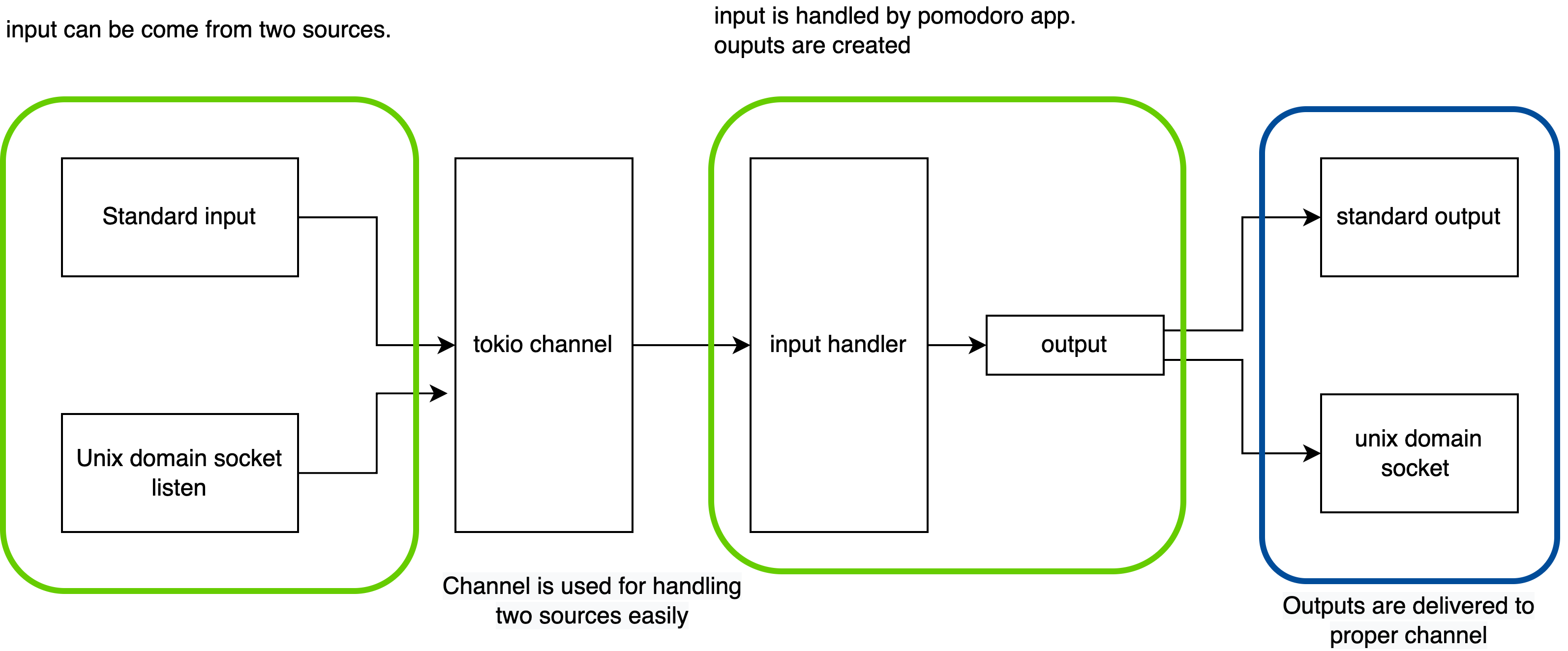

Pomodoro technique is a time management method (Refer the link for more information). Typically 25 minutes works and 5 minutes break is one set. For me, while I'm working I found intentional break time is needed for the better performance and health (do some stretching 5 minutes). So I made it.
Pomodoro supports two input types, standard input and IPC (via unix domain socket). To support them, the pomodoro app architecture looks like this.

Currently pomodoro provide the features listed as below. for more features, run pomodoro and type help!
- Create notification with customized work and break time
- When configuration file is given, notification is created with default values specified in the file
- Queue the notification. Queued notification will start to run after previously registered notifications are finished
- Customize notification delivery channels. Refer Using configuration.json section
- Pretty print created notifications using list command
- Delete registered notification(s)
- Track archived notification(s) using history command
- Delete archived notifications using history --clear command
- Clear terminal
- Support command history look up with arrow key in interaction mode.
(A notification is consisted of work time and break time. Pomodoro manages timer using notification.)
- Generate auto completion script for several shells (fish, zsh, bash, elvish, powershell)
Depend on the input types, command is provided slightly differently.
If you want to start up, run the pomodoro with proper OPTIONS.
Or if you want to send command to already started up pomodoro (via IPC), run the command with SUBCOMMANDS
```md pomodoro 1.4.0 Young start up application with config or run command using uds client
Usage: pomodoro [OPTIONS]
pomodoro
Commands: create create the notification queue create the notification delete delete a notification list list notifications history show archived notifications test test notification completion generate completions for shells help Print this message or the help of the given subcommand(s)
Options:
-c, --config
While pomodoro is running, you can interactively make command.
```md pomodoro 1.4.0 Young manage your time!
Usage: pomodoro [COMMAND]
Commands: create create the notification queue create the notification delete delete a notification list list notifications history show archived notifications test test notification clear clear terminal exit exit pomodoro app help Print this message or the help of the given subcommand(s)
Options: -h, --help Print help -V, --version Print version ```
cargo run --release or build your self and use binary as you wish.sh
git clone git@github.com:24seconds/rust-cli-pomodoro.git
cd rust-cli-pomodoro
cargo run --release
cargo install rust-cli-pomodoro
sh
cargo install rust-cli-pomodoro
pomodoro supports several configurations. - slack notification - discord notification - work time default value - break time default value
To use it, you need to create json file, for exmplae configuration.json in somewhere in your local machine.
Configuration.json file looks like below.
json
{
"slack": {
"token": "your-bot-token-string",
"channel": "your-slack-channel-id"
},
"discord": {
"webhook_url": "your-webhook-url"
},
"work_time_default_value": 30,
"break_time_default_value": 10
}
For the slack notification, It uses chat.PostMessage API
For the discord notification, It uses webhook url
To run pomodoro with configuration.json, run the app like this.
```sh
pomodoro --config ./configuration.json ```
rust-cli-pomodoro supports auto completion. But you need to generate the completion script manually and put it to the proper path.
Auto completion is tab completion. When you typed a few character and press tab, then you can see the possible commands like this.

You need to run the command to get completion script. The command looks like below.
```sh Usage: pomodoro completion [shell]
Arguments: [shell] [possible values: fish, zsh, bash, elvish, powershell] ```
For example, if you run pomodoro completion zsh then the script will be printed through standard output. Therefore, you need to do like this.
sh
$ pomodoro completion zsh > _pomodoro
The file name should be underscord + binary name, which is _pomodoro.
Put the completion script file to proper path. For example, in zsh shell, the proper path is one of $fpath. You can check by running this command.
```sh
echo $fpath ```
In my case, I put the completion script under /Users/young/.oh-my-zsh/completions.
To use the auto completion, you need to run this command for opened terminals. For the newly opened terminals, auto completion will work without problem.
```sh $ exec zsh
$ source ~/.zshrc ```
Enjoy!
mac-notification_sys doesn't support recent mac version (as of 17:10 Sun 17 Oct 2021) => published binary can send desktop notification without problem (01:21 Fri 13 May 2022)It depends on notify-rust support, so Linux, Mac (<= 11.0.0) and Windows (10, 8.1).
- note: If you use this app by installing cargo install command, then macOs desktop notification seems to work well (Sun 03 Apr 2022)
Currently Linux and Mac are supported (as pomodoro used unix domain socket)